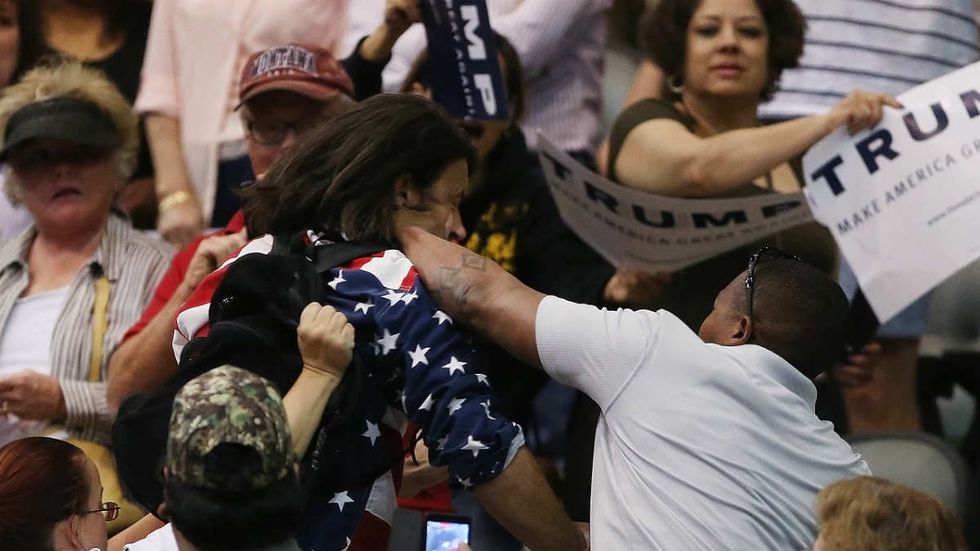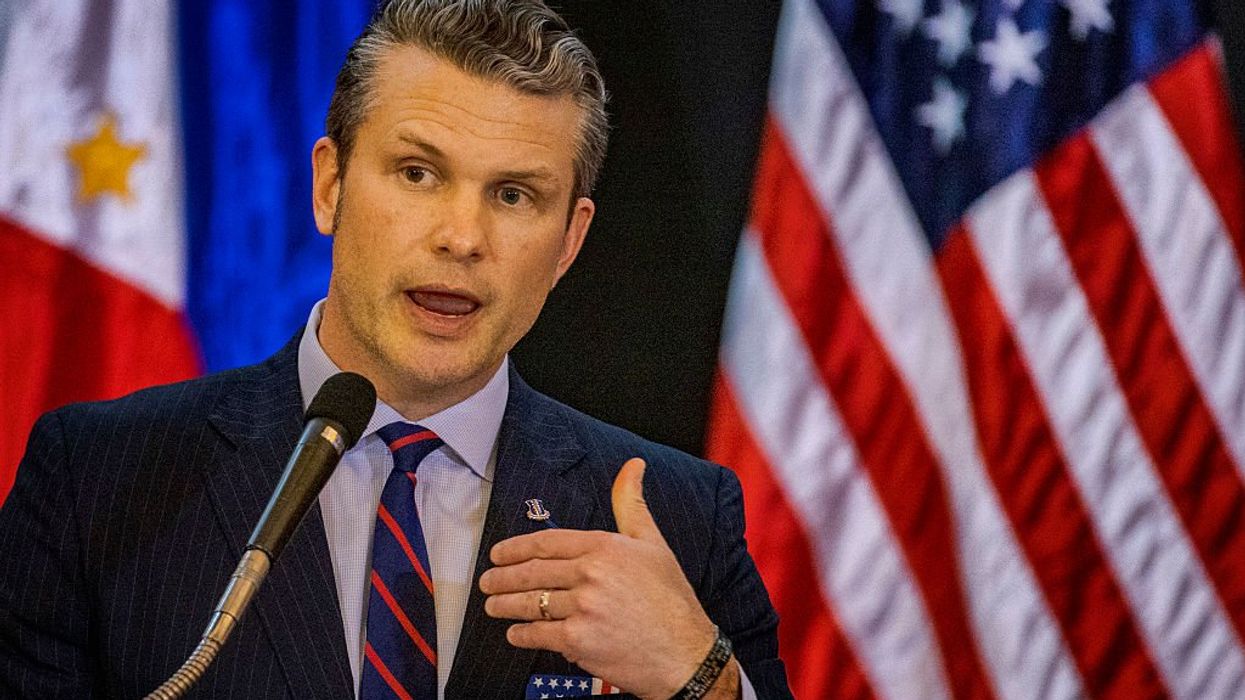
© 2025 Blaze Media LLC. All rights reserved.
I have been watching in despair as aggressive confrontation, provocation, and disruption by left-wing activists triggers more and more violent responses from the supporters of Donald Trump. There are no winners in this escalating violence. Everyone will lose.
I look at this current mess from the perspective of my personal history as an activist, a tea party organizer, and as a student of successful non-violent social movements. I was intimately involved in organizing the largest tea party rallies, including the September 12, 2009 March on Washington. What was most remarkable about that massive gathering of over a million activists was how perfectly peaceful and civil it was. Organizers, along with the U.S. Park Police, expected maybe tens of thousands. As a result, the infrastructure – law enforcement, barricades, health care support, the sound system, and the Porta-Johns – turned out to be grossly inadequate for the sea of humanity that descended on Freedom Plaza in Washington, D.C. that morning.
It should have been a disaster. Instead, it was beautiful chaos. Everyone was smiling, helping other people find their way, saying to others “sorry,” “excuse me,” and “thank you” as they struggled to move through the mass of humanity. No one was hurt, no one was arrested, and no windows were broken. Even protestors were engaged in conversation, not insults. We picked up our trash and left the National Mall spotless.
Later, as more hostile protestors began infiltrating our rallies, we had to maintain the peaceful nature of our gatherings by self-policing the community. Violence was not tolerated. Infiltrators with nasty signs were identified, and surrounded by activists with signs that pointed down, saying “Not With Us.” This tactic worked well on April 15, 2010, and a group called Crash The Tea Party launched a coordinated effort to provoke us.
All of this was a conscious effort, understanding that violence is not who we are as people, but also that violence is a bad strategy. At early tea party meetings that led up to the 9/12 March, we distributed copies of A Force More Powerful: A Century of Nonviolent Conflict by Peter Ackerman and Jack DuVall. We particularly studied the tactics of the American civil rights movement, and MLK’s insistence on the moral and tactical superiority of nonviolence.
We would learn how unique this insistence on nonviolence was with the emergence of Occupy Wall Street. I would write about the difference in the Wall Street Journal:
In contrast OWS, whose ranks represent a small fraction of total tea party protestors, has struggled to maintain civility or to even identify a unifying sense of purpose in their uprising. At Zuccotti Park in lower Manhattan, there is stealing, property damage and arrests often provoked by protestors wanting conflict with the police. Real people—not members of the so-called 1%—are being hurt as their small businesses are impacted and their property destroyed.
“Things have gone far worse in Europe. In Rome… a protest aligning itself with the OWS movement quickly devolved into a full-on riot, with the demonstrators smashing shop windows and torching cars. ‘Clad in black with their faces covered,’ the Associated Press reported, ‘protesters threw rocks, bottles and incendiary devices at banks and Rome police in riot gear. Some protesters had clubs, others had hammers. They destroyed bank ATMs, set trash bins on fire and assaulted at least two news crews from Sky Italia.’"
Today, the lines are hopelessly blurred between Trump supporters and their provocateurs. Every media outlet imaginable has a video montage of Trump activists pushing, punching and kicking disruptive interlopers from MoveOn.org and #BlackLivesMatter. The narrative for this election is now set: Trump and his supporters are violent. Is this fair? There is plenty of blame all around, but it won’t matter.
In one instance, an older white man blindsides a younger black man (who has just given the audience both of his middle fingers as he is escorted out) with an elbow and forearm to the face. Moments later, another anti-Trump activist, with his iPhone video recorder running, asks the assailant why he did it. “He’s not acting like an American,” he replies. “Yes, he deserved it. The next time we see him we might have to kill him.”
In Tucson, Arizona on March 19th, a black man supporting Trump punches, and kicks a white male protestor as he and another protestor wearing a Ku Klux Klan hood are being escorted out.
Make no mistake, Trump supporters are not the only ones throwing punches, and the primary purpose of many protestors infiltrating these events seems to be to do whatever it takes to incite a violent response. I pulled this paragraph from a very sympathetic article about students planning to disrupt the Trump rally that was ultimately canceled in Chicago:
Students couldn’t agree how—or where—to protest. Angry over recent news of activists being physically assaulted at Trump events, some felt they shouldn’t be passive if attacked on Friday night. But others like [Brian] Geiger—an African-American senior majoring in political science and an honors student at UIC—countered that non-violence was the only approach they could take. Anything else, he said, would reflect badly on them, the university and the cause. “What I’m fearful of,” he said, “is folks who are coming to this campus and want to start violence. That’s what scares me.”
If violence was the goal in Chicago, protestors certainly achieved their goal.
So it was in Tucson, Arizona. Watch this video posted by a black, male, off duty police officer, who went to the Trump rally simply “to hear what the man has to say.” His conclusion was that “the protestors were the problem.” “These people were acting so outrageous… you were just thinking that somebody was going to lose their temper and there was going to be a full brawl. I could not believe what I saw.”
Donald Trump himself feeds this fire. In my mind, he has a responsibility here to lead. Instead, he tells his audience, like one in Cedar Rapids: “If you see somebody getting ready to throw a tomato, knock the crap out of them, would you? Seriously. Okay? Just knock the hell — I promise you, I will pay for the legal fees. I promise, I promise.”
I would ask both sides in this increasingly dangerous situation to consider the words of Dr. Martin Luther King Jr., in his December 11, 1964 Nobel Lecture:
Violence… is impractical because it is a descending spiral ending in destruction for all. The old law of an eye for an eye leaves everybody blind. It is immoral because it seeks to humiliate the opponent rather than win his understanding; it seeks to annihilate rather than to convert. Violence is immoral because it thrives on hatred rather than love. It destroys community and makes brotherhood impossible. It leaves society in monologue rather than dialogue. Violence ends by destroying itself.
Want to leave a tip?
We answer to you. Help keep our content free of advertisers and big tech censorship by leaving a tip today.
Want to join the conversation?
Already a subscriber?
more stories
Sign up for the Blaze newsletter
By signing up, you agree to our Privacy Policy and Terms of Use, and agree to receive content that may sometimes include advertisements. You may opt out at any time.
© 2025 Blaze Media LLC. All rights reserved.
Get the stories that matter most delivered directly to your inbox.
By signing up, you agree to our Privacy Policy and Terms of Use, and agree to receive content that may sometimes include advertisements. You may opt out at any time.


